Study of the Interfacial Transition Zone Characteristics of Geopolymer and Conventional Concretes
Abstract
1. Introduction
2. Results and Discussion
2.1. Microstructure Analysis
2.2. Nanomechanical Properties
3. Conclusions
- SEM test results show that traditional concrete developed a weak ITZ with voids and cracks, while the geopolymer concrete microstructure did not present weak ITZs in the vicinity of aggregates.
- Nanoindentation results showed that, in geopolymer mixtures, there is no clear weak zone identified around the aggregate with lower modulus such as the ITZ typically observed from OPC mixtures. This observation can be attributed to the high bond strength of the geopolymer matrix.
- Geopolymer matrix presented multiple phases in different geometries (SEM results) and mechanical properties (nanoindentation results). Highly scattered stiffness values within the matrix phase were observed and seem strongly related to the formation of different compositions such as N-A-S-H gel, partially reacted fly ash particles and pores.
- The investigation of geopolymer matrix performed in this study will provide a better understanding on performance at large scales, which could lead to enlarge the filed application of geopolymer.
- For future study, it is recommended to investigate the effect of aggregate surface texture on the bond properties between the aggregate and binding agents.
4. Materials and Methods
4.1. Materials
4.2. Samples Preparation
4.3. Test Methods
Funding
Institutional Review Board Statement
Informed Consent Statement
Data Availability Statement
Acknowledgments
Conflicts of Interest
References
- Shane, J.D.; Mason, T.O.; Jennings, H.M.; Garboczi, E.J.; Bentz, D.P. Effect of the interfacial transition zone on the conductivity of Portland cement mortars. J. Am. Ceram. Soc. 2000, 83, 1137–1144. [Google Scholar] [CrossRef]
- Scrivener, K.L.; Crumbie, A.K.; Laugesen, P. The interfacial transition zone (ITZ) between cement paste and aggregate in concrete. Interface Sci. 2004, 12, 411–421. [Google Scholar] [CrossRef]
- Xiao, J.; Li, W.; Corr, D.J.; Shah, S.P. Effects of interfacial transition zones on the stress–strain behavior of modeled recycled aggregate concrete. Cem. Concr. Res. 2013, 52, 82–99. [Google Scholar] [CrossRef]
- Mondal, P. Nanomechanical Properties of Cementitious Materials. Ph.D. Thesis, Northwestern University, Evanston, IL, USA, 2008. [Google Scholar]
- Gao, Y.; De Schutter, G.; Ye, G.; Tan, Z.; Wu, K. The ITZ microstructure, thickness and porosity in blended cementitious composite: Effects of curing age, water to binder ratio and aggregate content. Compos. Part. B Eng. 2014, 60, 1–13. [Google Scholar] [CrossRef]
- Akçaoğlu, T.; Tokyay, M.; Çelik, T. Assessing the ITZ microcracking via scanning electron microscope and its effect on the failure behavior of concrete. Cem. Concr. Res. 2005, 35, 358–363. [Google Scholar] [CrossRef]
- Erdem, S.; Dawson, A.R.; Thom, N.H. Influence of the micro-and nanoscale local mechanical properties of the interfacial transition zone on impact behavior of concrete made with different aggregates. Cem. Concr. Res. 2012, 42, 447–458. [Google Scholar] [CrossRef]
- Cwirzen, A.; Penttala, V. Aggregate–cement paste transition zone properties affecting the salt–frost damage of high-performance concretes. Cem. Concr. Res. 2005, 35, 671–679. [Google Scholar] [CrossRef]
- Simeonov, P.; Ahmad, S. Effect of transition zone on the elastic behavior of cement-based composites. Cem. Concr. Res. 1995, 25, 165–176. [Google Scholar] [CrossRef]
- Shi, Y.; Lv, X.; Zhou, S.; Liu, Z.A.; Yang, M.; Liu, C.; Lu, C. Mechanical properties, durability, and ITZ characteristics of full-grade dam concrete prepared by aggregates with surface rust stains. Constr. Build. Mater. 2021, 305, 124798. [Google Scholar] [CrossRef]
- Diamond, S.; Huang, J. The ITZ in concrete–A different view based on image analysis and SEM observations. Cem. Concr. Compos. 2001, 23, 179–188. [Google Scholar] [CrossRef]
- Scrivener, K.L. Backscattered electron imaging of cementitious microstructures: Understanding and quantification. Cem. Concr. Compos. 2004, 26, 935–945. [Google Scholar] [CrossRef]
- Bao, H.; Xu, G.; Yu, M.; Wang, Q.; Li, R.; Saafi, M.; Ye, J. Evolution of ITZ and its effect on the carbonation depth of concrete under supercritical CO2 condition. Cem. Concr. Compos. 2021, 126, 104336. [Google Scholar] [CrossRef]
- Zhu, W.; Bartos, P.J.M. Assessment of interfacial microstructure and bond properties in aged GRC using a novel microindentation method. Cem. Concr. Res. 1997, 27, 1701–1711. [Google Scholar] [CrossRef]
- Trtik, P.; Bartos, P.J. Micromechanical properties of cementitious composites. Mater. Struct. 1999, 32, 388–393. [Google Scholar] [CrossRef]
- Oliver, W.C.; Pharr, G.M. An improved technique for determining hardness and elastic modulus using load and displacement sensing indentation experiments. J. Mater. Res. 1992, 7, 1564–1583. [Google Scholar] [CrossRef]
- Constantinides, G.; Ulm, F.J. The effect of two types of CSH on the elasticity of cement-based materials: Results from nanoindentation and micromechanical modeling. Cem. Concr. Res. 2004, 34, 67–80. [Google Scholar] [CrossRef]
- Jennings, H.M.; Thomas, J.J.; Gevrenov, J.S.; Constantinides, G.; Ulm, F.J. A multi-technique investigation of the nanoporosity of cement paste. Cem. Concr. Res. 2007, 37, 329–336. [Google Scholar] [CrossRef]
- Mondal, P.; Shah, S.P.; Marks, L. A reliable technique to determine the local mechanical properties at the nanoscale for cementitious materials. Cem. Concr. Res. 2007, 37, 1440–1444. [Google Scholar] [CrossRef]
- Wang, X.H.; Jacobsen, S.; He, J.Y.; Zhang, Z.L.; Lee, S.F.; Lein, H.L. Application of nanoindentation testing to study of the interfacial transition zone in steel fiber reinforced mortar. Cem. Concr. Res. 2009, 39, 701–715. [Google Scholar] [CrossRef]
- Khedmati, M.; Kim, Y.R.; Turner, J.A.; Alanazi, H.; Nguyen, C. An integrated microstructural-nanomechanical-chemical approach to examine material-specific characteristics of cementitious interphase regions. Mater. Charact. 2018, 138, 154–164. [Google Scholar] [CrossRef]
- Turner, L.K.; Collins, F.G. Carbon dioxide equivalent (CO2-e) emissions: A comparison between geopolymer and OPC cement concrete. Constr. Build. Mater. 2013, 43, 125–130. [Google Scholar] [CrossRef]
- Mohammed, A.A.; Ahmed, H.U.; Mosavi, A. Survey of Mechanical Properties of Geopolymer Concrete: A Comprehensive Review and Data Analysis. Materials 2021, 14, 4690. [Google Scholar] [CrossRef] [PubMed]
- Davidovits, J. Geopolymer, Green Chemistry and Sustainable Development Solutions: Proceedings of the World Congress Geopolymer 2005; Geopolymer Institute: Saint-Quentin, France, 2005. [Google Scholar]
- Huseien, G.F.; Mirza, J.; Ismail, M.; Ghoshal, S.K.; Hussein, A.A. Geopolymer mortars as sustainable repair material: A comprehensive review. Renew. Sustain. Energ. Rev. 2017, 80, 54–74. [Google Scholar]
- Duan, P.; Yan, C.; Zhou, W. Influence of partial replacement of fly ash by metakaolin on mechanical properties and microstructure of fly ash geopolymer paste exposed to sulfate attack. Ceram. Int. 2016, 42, 3504–3517. [Google Scholar] [CrossRef]
- Nath, P.; Sarker, P.K. Use of OPC to improve setting and early strength properties of low calcium fly ash geopolymer concrete cured at room temperature. Cem. Concr. Compos. 2015, 55, 205–214. [Google Scholar] [CrossRef]
- Ahmed, H.U.; Mohammed, A.A.; Rafiq, S.; Mohammed, A.S.; Mosavi, A.; Sor, N.H.; Qaidi, S. Compressive Strength of Sustainable Geopolymer Concrete Composites: A State-of-the-Art Review. Sustainability 2021, 13, 13502. [Google Scholar] [CrossRef]
- Ariffin, M.A.M.; Bhutta, M.A.R.; Hussin, M.W.; Mohd Tahir, M.; Aziah, N. Sulfuric acid resistance of blended ash geopolymer concrete. Constr. Build. Mater. 2013, 43, 80–86. [Google Scholar] [CrossRef]
- Sanni, S.H.; Khadiranaikar, R.B. Performance of geopolymer concrete under severe environmental conditions. Int. J. Civ. Eng. Struct. Eng. 2012, 3, 396–407. [Google Scholar]
- Reddy, D.V.; Edouard, J.B.; Sobhan, K. Durability of Fly Ash–Based Geopolymer Structural Concrete in the Marine Environment. J. Mater. Civ. Eng. 2012, 25, 781–787. [Google Scholar] [CrossRef]
- Sharif, H.H. Fresh and Mechanical Characteristics of Eco-efficient Geopolymer Concrete Incorporating Nano-silica: An Overview. Kurd. J. App. Res. 2021, 64–74. [Google Scholar] [CrossRef]
- Khedmati, M.; Alanazi, H.; Kim, Y.R.; Nsengiyumva, G.; Moussavi, S. Effects of Na2O/SiO2 molar ratio on properties of aggregate-paste interphase in fly ash-based geopolymer mixtures through multiscale measurements. Constr. Build. Mater. 2018, 191, 564–574. [Google Scholar] [CrossRef]
- Škvára, F.; Kopecký, L.; Nemecek, J.; Bittnar, Z. Microstructure of geopolymer materials based on fly ash. Ceram Silik. 2006, 50, 208–215. [Google Scholar]
- Li, W.; Xiao, J.; Kawashima, S.; Shekhawat, G.S.; Shah, S.P. Experimental Investigation on Quantitative Nanomechanical Properties of Cement Paste. ACI Mater. J. 2015, 112, 229–238. [Google Scholar] [CrossRef][Green Version]
- Němeček, J.; Šmilauer, V.; Kopecký, L. Nanoindentation characteristics of alkali-activated aluminosilicate materials. Cem. Concr. Compos. 2011, 33, 163–170. [Google Scholar] [CrossRef]
- Šmilauer, V.; Škvára, F.; Němeček, J.; Kopecký, L.; Hlaváček, P. Application of Micromechanics on Alkali-activated Materials. Adv. Sci. Technol. 2010, 69, 75–85. [Google Scholar]
- Garcia-Lodeiro, I.; Palomo, A.; Fernández-Jiménez, A.; Macphee, D.E. Compatibility studies between N-A-S-H and C-A-S-H gels. Study in the ternary diagram Na2O-CaO-Al2O3-SiO2-H2O. Cem. Concr. Res. 2011, 41, 923–931. [Google Scholar] [CrossRef]
- Mondal, P.; Shah, S.; Marks, L. Nanomechanical properties of interfacial transition zone in concrete. In Nanotechnology in Construction 3; Springer: Berlin, Germany, 2009; pp. 315–320. [Google Scholar]
- Zhang, J.; Sun, H.; Wan, J.; Yi, Z. Study on microstructure and mechanical property of interfacial transition zone between limestone aggregate and Sialite paste. Constr. Build. Mater. 2009, 23, 3393–3397. [Google Scholar] [CrossRef]
- Vandamme, M. The Nanogranular Origin of Concrete Creep: A Nanoindentation Investigation of Microstructure and Fundamental Properties of Calcium-Silicate-Hydrates. Ph.D. Thesis, Massachusetts Institute of Technology, Boston, MA, USA, 2008. [Google Scholar]
- Zhu, W.; Sonebi, M.; Bartos, P.J.M. Bond and interfacial properties of reinforcement in self-compacting concrete. Mater. Struct. 2004, 37, 442. [Google Scholar] [CrossRef]
- Alanazi, H.; Yang, M.; Zhang, D.; Gao, Z.J. Bond strength of PCC pavement repairs using metakaolin-based geopolymer mortar. Cem. Concr. Compos. 2016, 65, 75–82. [Google Scholar] [CrossRef]
- Wei, Y.; Gao, X.; Liang, S. Nanoindentation-based study of the micro-mechanical properties, structure, and hydration degree of slag-blended cementitious materials. J. Mater. Sci. 2016, 51, 3349–3361. [Google Scholar] [CrossRef]
- Mitsui, K.; Li, Z.; Lange, D.A.; Shah, S.P. Relationship between microstructure and mechanical properties of paste-aggregate interface. ACI Mater. J. 1994, 91, 30–39. [Google Scholar]
- Lloyd, R.R.; Provis, J.L.; van Deventer, J.S. Microscopy and microanalysis of inorganic polymer cements. 2: The gel binder. J. Mater. Sci. 2009, 44, 620–631. [Google Scholar] [CrossRef]
- Aligizaki, K.K. Pore Structure of Cement-Based Materials—Testing, Interpretation and Requirement; Taylor & Francis: New York, NY, USA, 2006. [Google Scholar]
- Morsy, M.S.; Alsayed, S.H.; Al-Salloum, Y.; Almusallam, T. Effect of sodium silicate to sodium hydroxide ratios on strength and microstructure of fly ash geopolymer binder. Arab. J. Sci. Eng. 2014, 39, 4333–4339. [Google Scholar] [CrossRef]
- Pradhan, S.; Kumar, S.; Barai, S.V. Multi-scale characterisation of recycled aggregate concrete and prediction of its performance. Cem. Concr. Compos. 2020, 106, 103480. [Google Scholar] [CrossRef]
- Li, W.; Kawashima, S.; Xiao, J.; Corr, D.J.; Shi, C.; Shah, S.P. Comparative investigation on nanomechanical properties of hardened cement paste. Mater. Struct. 2016, 49, 1591–1604. [Google Scholar] [CrossRef]
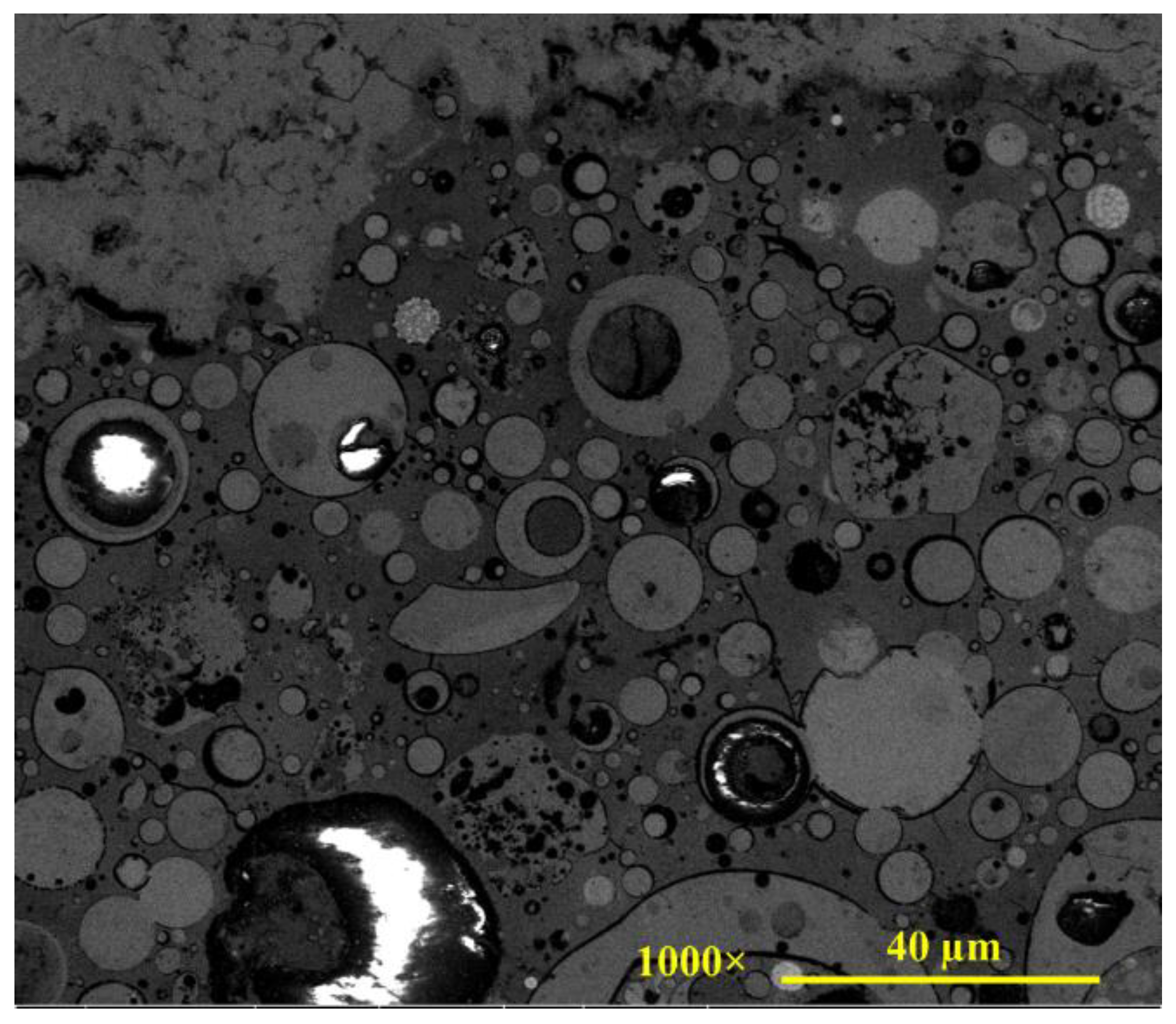

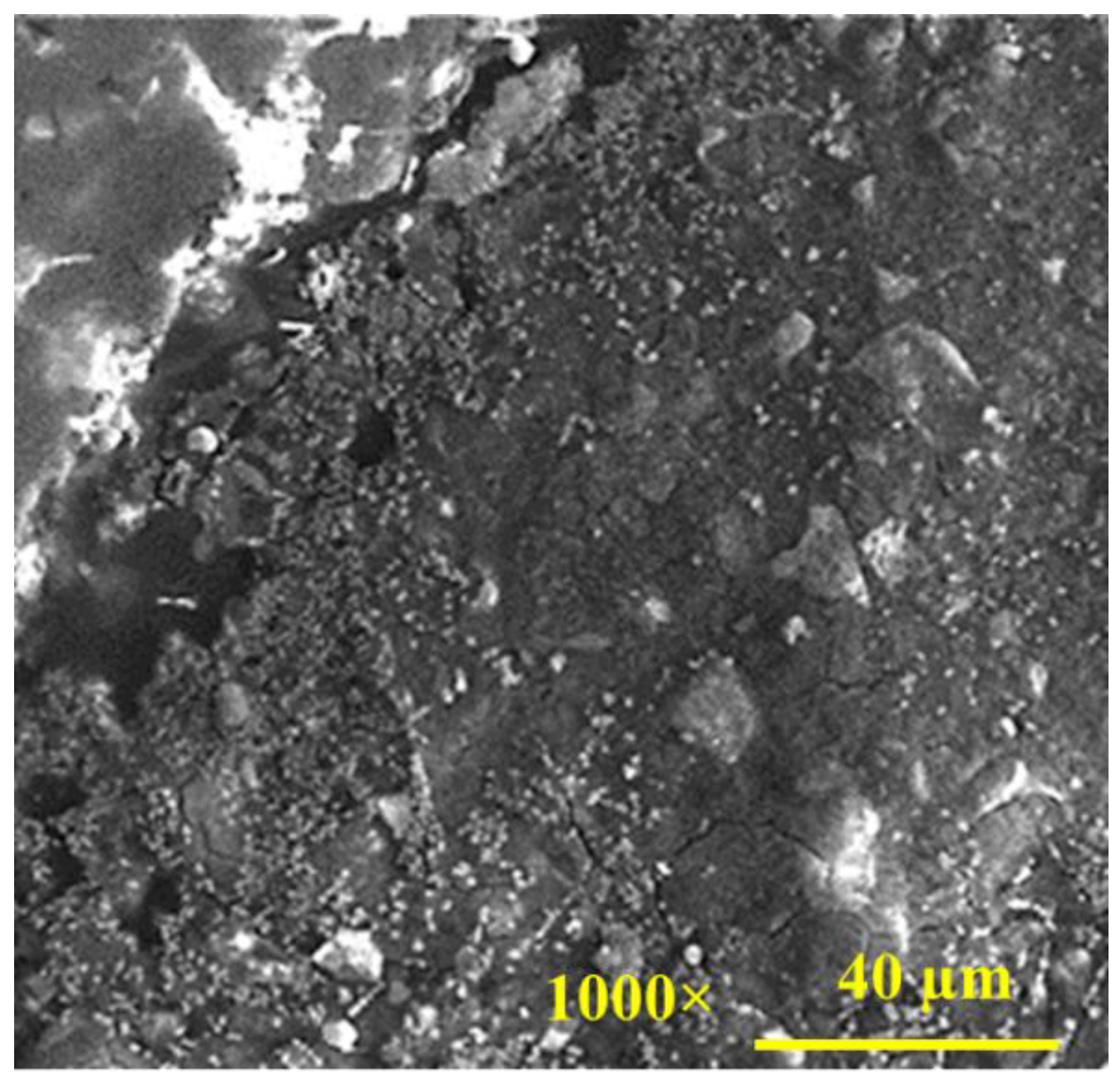
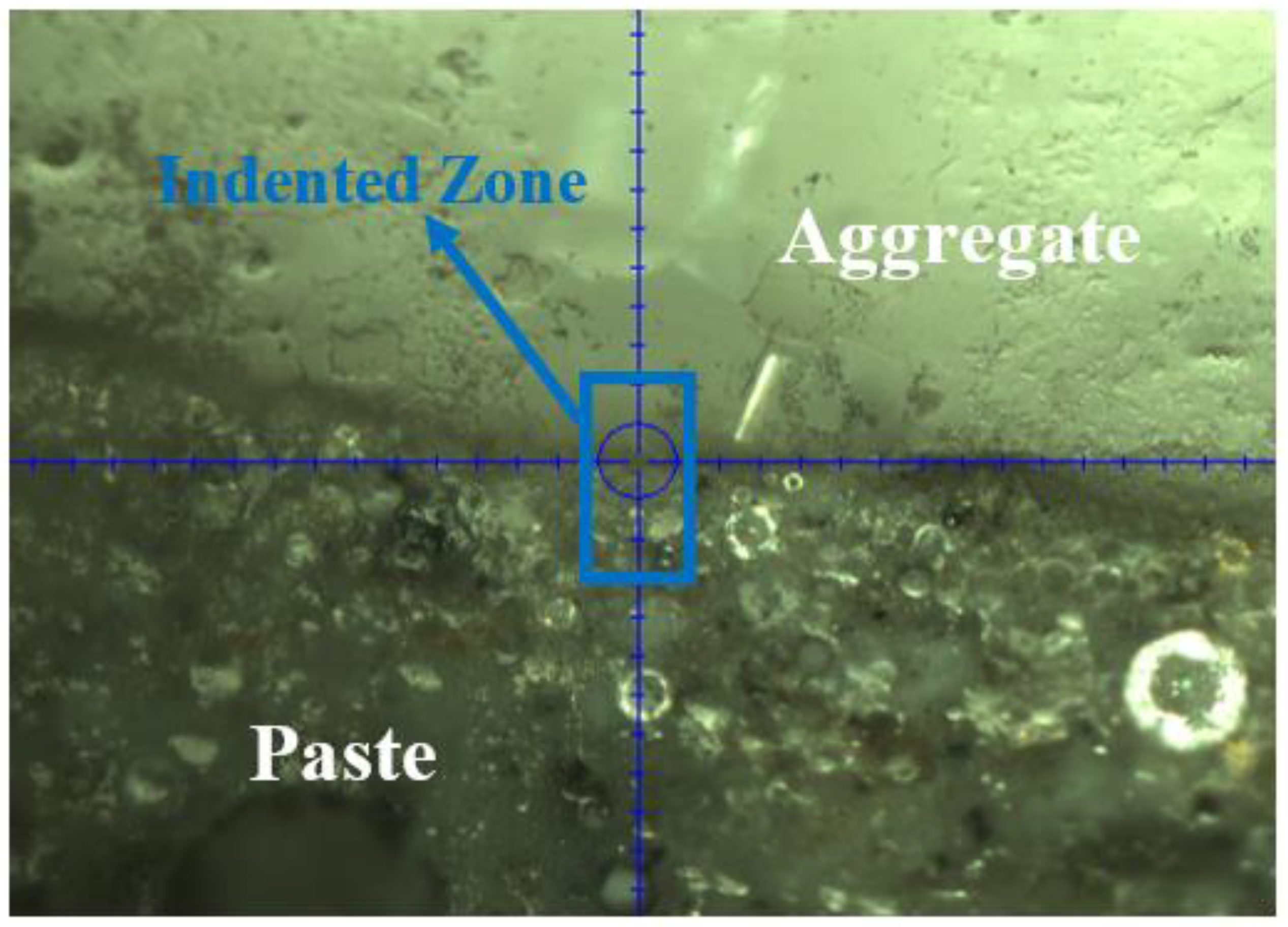

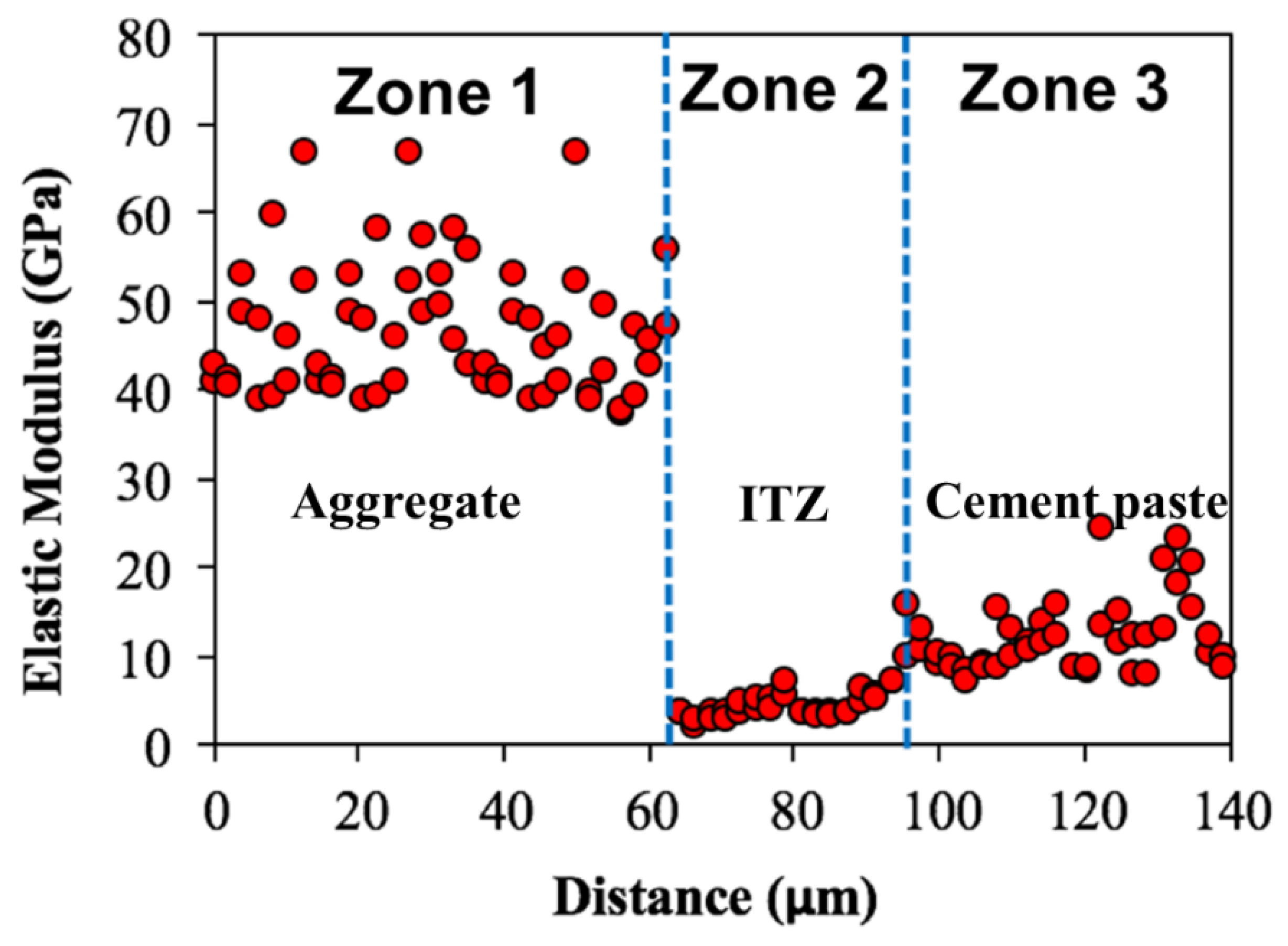
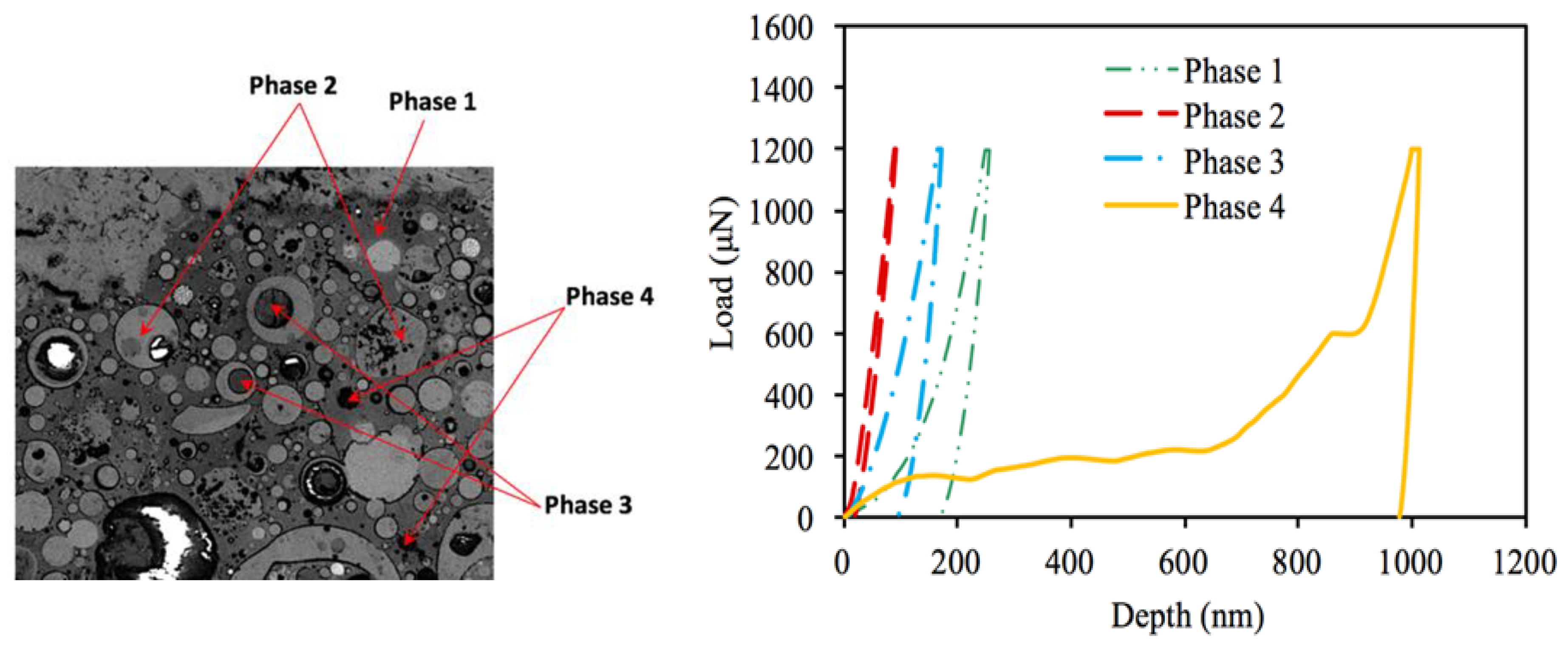
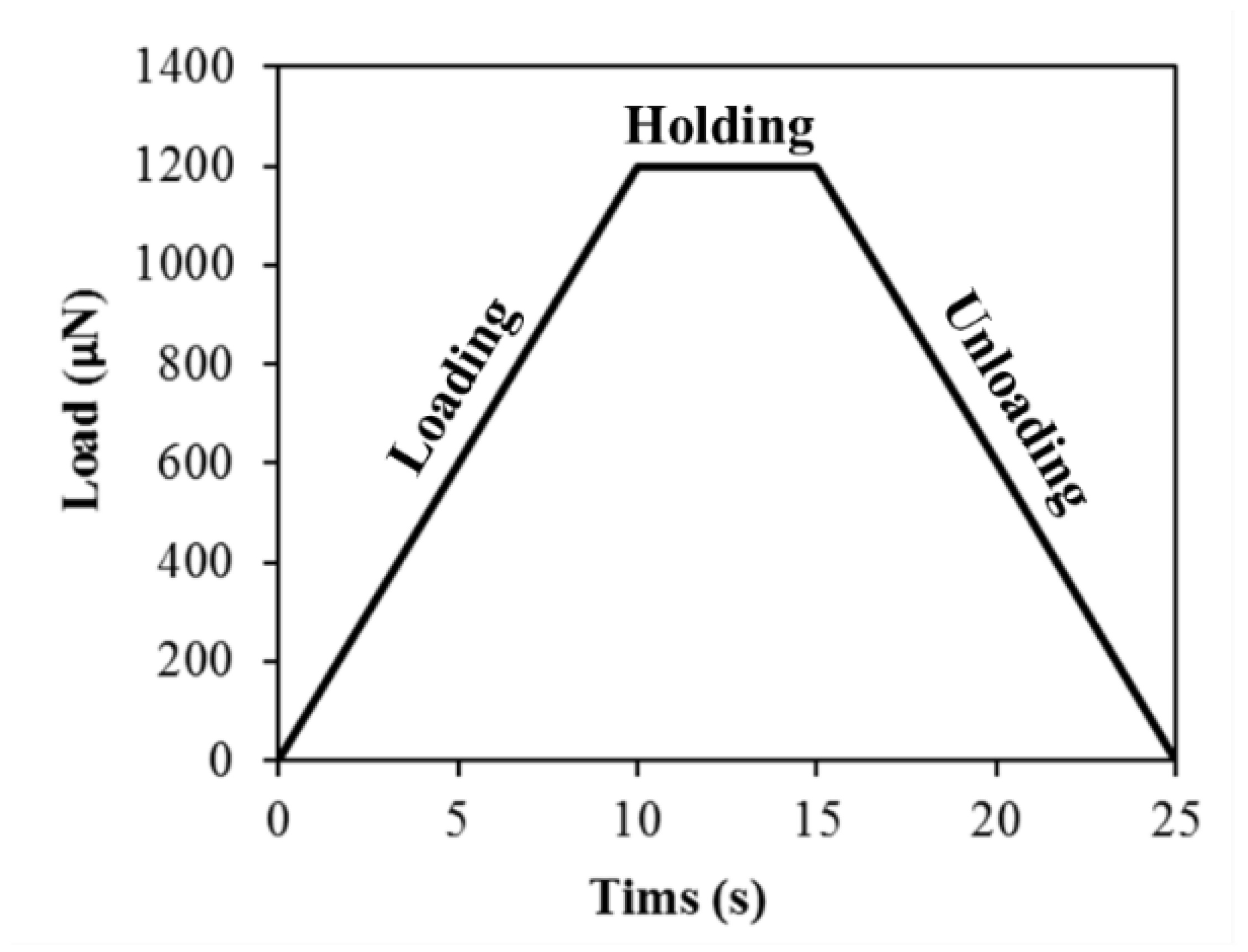
| Mix | Portland Cement, g | Fly Ash, g | Coarse Aggregate Fraction (mm), g | Water, mL | Sodium Silicate Solution, mL | Sodium Hydroxide Solution, mL | ||
|---|---|---|---|---|---|---|---|---|
| 19–12.5 | 12.5–9.5 | 9.5–4.75 | ||||||
| Geopolymer | 0 | 1000 | 680 | 567 | 453 | 0 | 286 | 114 |
| OPC | 1000 | 0 | 680 | 567 | 453 | 400 | 0 | 0 |
Publisher’s Note: MDPI stays neutral with regard to jurisdictional claims in published maps and institutional affiliations. |
© 2022 by the author. Licensee MDPI, Basel, Switzerland. This article is an open access article distributed under the terms and conditions of the Creative Commons Attribution (CC BY) license (https://creativecommons.org/licenses/by/4.0/).
Share and Cite
Alanazi, H. Study of the Interfacial Transition Zone Characteristics of Geopolymer and Conventional Concretes. Gels 2022, 8, 105. https://doi.org/10.3390/gels8020105
Alanazi H. Study of the Interfacial Transition Zone Characteristics of Geopolymer and Conventional Concretes. Gels. 2022; 8(2):105. https://doi.org/10.3390/gels8020105
Chicago/Turabian StyleAlanazi, Hani. 2022. "Study of the Interfacial Transition Zone Characteristics of Geopolymer and Conventional Concretes" Gels 8, no. 2: 105. https://doi.org/10.3390/gels8020105
APA StyleAlanazi, H. (2022). Study of the Interfacial Transition Zone Characteristics of Geopolymer and Conventional Concretes. Gels, 8(2), 105. https://doi.org/10.3390/gels8020105






